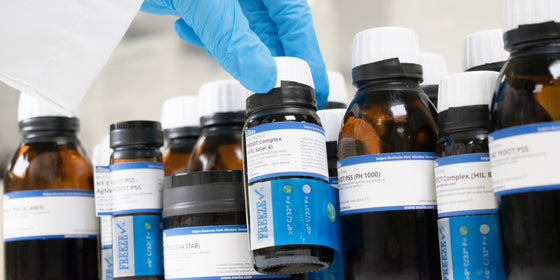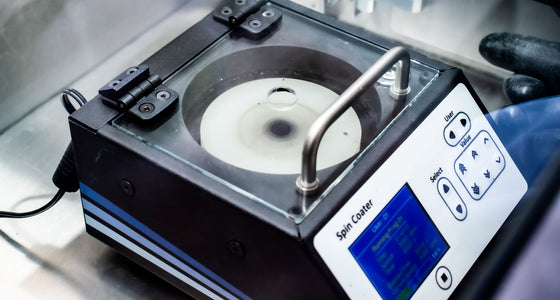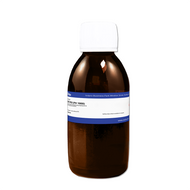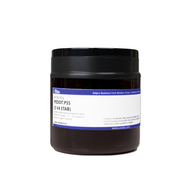Poly(3,4-ethylenedioxythiophene) Conductive Polymer

Jump to: Popular Poly(3,4-ethylenedioxythiophene) Polymer Blends | Poly(3,4-ethylenedioxythiophene) Properties | Complexes | Applications | Synthesis
Poly(3,4-ethylenedioxythiophene), referred to as PEDOT, is an intrinsically conducting polymer (ICP), defined as being composed of macromolecules with conjugated sequences of double bonds along its chains.
PEDOT is a polymer of 3,4-ethylenedioxythiophene, referred to as EDOT. EDOT is a monomer based on a thiophene group which is able to undergo an oxidation reaction to polymerize. PEDOT is a highly conductive polymer which has attracted the attention of researchers working in organic electronics and more. Having a polymer that is able to conduct electricity so well and maintain flexibility has proved highly beneficial in the development of organic solar cell, light-emitting diodes and more.
Popular Poly(3,4-ethylenedioxythiophene) Polymer Blends
Unfortunately, pristine poly(3,4-ethylenedioxythiophene) is insoluble in many useful solvents. Therefore, PEDOT requires a stabilizing or dopant polymer or molecular counterion. Polystyrene sulfonate (PSS) is most commonly used. The sulfonate group (-SO3H) is a pendant unit which interacts with PEDOT. PSS coats the insoluble PEDOT, creating nano-size particles of PEDOT:PSS, which form a stable colloidal dispersion in water. PSS is currently the most successful PEDOT counterpart, but other options are available, especially for non-aqueous dispersions:
Browse more PEDOT polymer blends
Poly(3,4-ethylenedioxythiophene) Properties
Poly(3,4-ethylenedioxythiophene) is one of the most popular conductive polymers used in electronic device research. This is due to the numerous exciting and useful properties that is possesses. The properties that separate it from other similar polymers include:
High Conductivity
Poly(3,4-ethylenedioxythiophene) has a conjugated polymer backbone, enabling π-electron delocalization. Upon oxidation, it generates mobile positive charge carriers (holes) that move along the backbone. These carriers exist as polarons and bipolarons, which are localized charges associated with structural distortions in the polymer chain, that facilitate charge transport.
High Stability
Poly(3,4-ethylenedioxythiophene) has drawn attention in both academic research and industrial applications due to its relative high stability compared to other intrinsically conductive polymers. The addition of the electron donating sulfur heteroatom into the main conjugated chain via the thiophene group has enabled the stabilization of the π-electron system. The dioxy group provides further stability and the bicyclic rings decrease steric hinderance.
Optical Transparency
When poly(3,4-ethylenedioxythiophene) is oxidized, it forms new energy levels called polarons and bipolarons within its original band gap. This narrows the band gap between the HOMO and LUMO allowing for lower-energy optical transitions. These new states allow the material to absorb light at lower energies, specifically in the near-infrared (NIR) region rather than visible light. This lack of absorption of visible light is what give the polymer its transparent properties.
Low Solubility
Chemically synthesized poly(3,4-ethylenedioxythiophene) is black and insoluble. Electrochemical methods require the growth of PEDOT on conductive substrate rather than it being formed in solution. By polymerizing EDOT in the presence of counter-anions, most commonly the the sodium salt of polystyrene sulfonate (PSS), PEDOT can be synthesized in an aqueous solution directly with high stability. Whilst PSS is the most popular counter-anion, others are available and may provide further stability in a given application.
Poly(3,4-ethylenedioxythiophene) Complexes

Poly(3,4-ethylenedioxythiophene) is most commonly found as a composite with PSS. Most PEDOT:PSS formulations are aqueous, which is not ideal for devices with moisture-sensitive active layers, such as perovskite solar cells and OLEDs.
For devices requiring a conductive layer that won’t compromise the active layer due to water exposure, PEDOT complexes in alternative solvents are recommended.
Our PEDOT complexes come in:
Toluene - HTL Solar 3 PEDOT Complex
Butyl benzoate - HIL 8 PEDOT Complex
Anisole - HTL Solar 4 PEDOT Complex
These solvents promote highly crystalline thin film formation, enhancing conductivity while also improving the wetting and coating of subsequent layers.
Poly(3,4-ethylenedioxythiophene) Applications

Poly(3,4-ethylenedioxythiophene) is by far one of the most successful conductive polymers. It is compatible with many solution processing techniques, including:
- Dip coating
- Spin coating
- Slot die coating
- Spray coating
- Blade coating
- Inkjet printing
- Screen printing
This means you can coat a range of substrates with PEDOT based polymer solutions, rigid or flexible, regular or irregular. This makes it an ideal conductive layer in devices including sensors, biosensors, organic electrochemical transistors and supercapacitors.
Popular Applications of Poly(3,4-ethylenedioxythiophene)
Perovskite Photovoltaics
PEDOT based polymer blends have been used as hole extraction material in inverted perovskite solar cells.
Organic Solar Cells
PEDOT based polymer blends have been used as the hole transport layer in organic solar cells.
Organic Light-Emitting Diodes
PEDOT based polymer blends have been the materials of choice for the injection of holes into OLEDs.
Transparent Conductors
PEDOT polymer blends are able to reach sheet resistances comparable to metallic films whilst being transparent.
Poly(3,4-ethylenedioxythiophene) Synthesis
There are two key methods to synthesize soluble poly(3,4-ethylenedioxythiophene). Via oxidative chemical polymerization and electrochemical polymerization. Transition metal-mediated coupling, also referred to as the Yamamoto method, can be used to synthesize PEDOT but the product is insoluble and therefore PEDOT cannot be easily processed.
Oxidative Chemical Polymerization
Poly(3,4-ethylenedioxythiophene) can be synthesized via oxidative chemical polymerization using oxidant/catalyst, solvent, EDOT, a substrate and optional surfactant, inhibitor and cosolvent. Chemical oxidation follows a multi-step reaction including the oxidation of the monomer o form cationic radicals, free radical dimerization, deprotonation and dimer oxidation followed by polymerization.
Popular oxidation catalysts include iron (III) complexes such as iron(III) chloride and iron(III) tosylate. There can be further steps taken to modify the synthesis process to control the properties of poly(3,4-ethylenedioxythiophene). This allows researchers to tailor the properties for specific applications.
Electrochemical Polymerization
Poly(3,4-ethylenedioxythiophene) can also be produced via the electrochemical polymerization of EDOT. It is a method for producing thin films of the conducting polymer PEDOT on a substrate directly, typically the working electrode. This process takes place in a three-electrode electrochemical cell containing an EDOT electrolyte solution. When a potential is applied between the working and counter electrodes, EDOT monomers oxidize to form radical cations, which then polymerize into PEDOT chains. The resulting PEDOT film incorporates electrolyte anions to balance its charge.
Common electrolytes used include lithium perchlorate (LiClO₄), BMIMPF₆, and LiTFSI. PEDOT's transparency and conductivity make it valuable in devices such as solar cells, OLEDs, sensors, and supercapacitors. However, its hydrophobicity makes processing challenging, a problem addressed by blending it with hydrophilic polystyrene sulfonate (PSS).
Learn More
 PEDOT:PSS Applications
PEDOT:PSS Applications
PEDOT:PSS stands out as a promising conductive polymer due to its large range of conductivities, transparency, flexibility, and ease of processing.
Read more...PEDOT synthesis involves the oxidative chemical or electrochemical polymerization of EDOT monomer.
Read more...
References
- Intrinsically conducting polymer, IUPAC, IUPAC Compendium of Chemical Terminology (2025)
- Progress in understanding structure and transport properties of..., Gueye, M. N. et al., Progress in Materials Science (2020)
Contributors
Written by
Application Scientist
Application Scientist
Diagrams by
Graphic Designer




